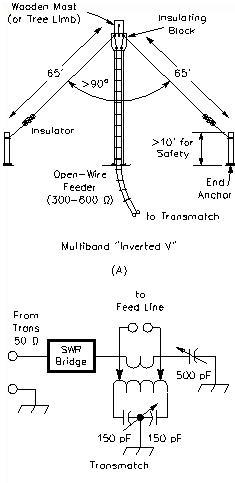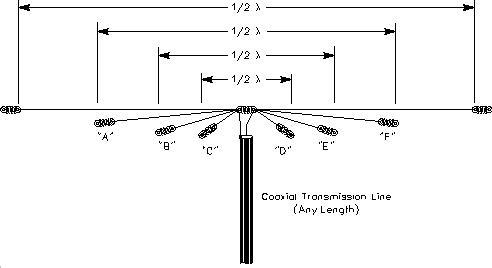A classic dipole antenna is 1/2-l long and fed at the center. The feed-point impedance is low at the resonant frequency, f0, and odd harmonics thereof. The impedance is high near even harmonics. When fed with coax, a classic dipole provides a reasonably low SWR at f0 and its odd harmonics.
When fed with ladder line (see Fig 20.8A) and a Transmatch, the classic dipole should be usable near f0 and all harmonic frequencies. (With a wide-range Transmatch, it may work on all frequencies.) If there are problems (such as extremely high SWR or evidence of RF on objects at the operating position), change the feed-line length by adding or subtracting 1/8 l at the problem frequency. A few such adjustments should yield a workable solution. Such a system is sometimes called a "center-fed Zepp." A true "Zepp" antenna is an end-fed dipole that is matched by 1/4 l of open-wire feed line (see Fig 20.8B). The antenna was originally used on zeppelins, with the dipole trailing from the feeder, which hung from the airship cabin. It is intended for use on a single band, but should be usable near odd harmonics of f0.
Most dipoles require a little pruning to reach the desired resonant frequency. Here’s a technique to speed the adjustment.
How much to prune: When assembling the antenna, cut the wire 2 to 3% longer than the calculated length and record the length. When the antenna is complete, raise it to the working height and check the SWR at several frequencies. Multiply the frequency of the SWR minimum by the antenna length and divide the result by the desired f0. The result is the finished length; trim both ends equally to reach that length and you’re done.
Loose ends: Here’s another trick, if you use nonconductive end support lines. When assembling the antenna, mount the end insulators in about 5% from the ends. Raise the antenna and let the ends hang free. Figure how much to prune and cut it from the hanging ends. If the pruned ends are very long, wrap them around the insulated line for support.

Fig 20.8—Center-fed multiband "Zepp" antenna (A) and an end-fed Zepp at (B).
Dipole Orientation
Dipole antennas need not be installed in a horizontal straight line. They are generally tolerant of bending, sloping or drooping as required by the antenna site. Remember, however, that dipole antennas are RF conductors. For safety’s sake, mount all antennas away from conductors (especially power lines), combustibles and well beyond the reach of passersby.
A sloping dipole is shown in Fig 20.9. This antenna is often used to favor one direction (the "forward direction" in the figure). With a nonconducting support and poor earth, signals off the back are weaker than those off the front. With a nonconducting mast and good earth, the response is omnidirectional. There is no gain in any direction with a nonconducting mast.
A conductive support such as a tower acts as a parasitic element. (So does the coax shield, unless it is routed at 90° from the antenna.) The parasitic effects vary with earth quality, support height and other conductors on the support (such as a beam at the top). With such variables, performance is very difficult to predict.
Losses increase as the antenna ends approach the support or the ground. To prevent feed-line radiation, route the coax away from the feed-point at 90° from the antenna, and continue on that line as far as possible.

Fig 20.9—Example of a sloping 1/2-l dipole, or "full sloper." On the lower HF bands, maximum radiation over poor to average earth is off the sides and in the "forward direction" as indicated, if a nonconductive support is used. A metal support will alter this pattern by acting as a parasitic element. How it alters the pattern is a complex issue depending on the electrical height of the mast, what other antennas are located on the mast, and on the configuration of guy wires.
An Inverted V antenna appears in Fig 20.10. While "V" accurately describes the shape of this antenna, this antenna should not be confused with long-wire V antennas, which are highly directive. The radiation pattern and dipole impedance depend on the apex angle, and it is very important that the ends do not come too close to lossy ground.

Fig 20.10—At A, details for an inverted V fed with open-wire line for multiband HF operation. A Transmatch is shown at B, suitable for matching the antenna to the transmitter over a wide frequency range. The included angle between the two legs should be greater than 90° for best performance.
Bent dipoles may be used where antenna space is at a premium. Fig 20.11 shows several possibilities; there are many more. Bending distorts the radiation pattern somewhat and may affect the impedance as well, but compromises are acceptable when the situation demands them. When an antenna bends back on itself (as in Fig 20.11B) some of the signal is canceled; avoid this if possible.
Remember that current produces the radiated signal, and current is maximum at the dipole center. Therefore, performance is best when the central area of the antenna is straight, high and clear of nearby objects. Be safe! Keep any bends, sags or hanging ends well clear of conductors (especially power lines) and combustibles, and beyond the reach of persons.

Fig 20.11—When limited space is available for a dipole antenna, the ends can be bent downward as shown at A, or back on the radiator as shown at B. The inverted V at C can be erected with the ends bent parallel with the ground when the available supporting structure is not high enough.
Multiband Dipoles
There are several ways to construct coax-fed multiband dipole systems. These techniques apply to dipoles of all orientations. Each method requires a little more work than a single dipole, but the materials don’t cost much.
Parallel dipoles are a simple and convenient answer. See Fig 20.12. Center-fed dipoles present low-impedances near f0, or its odd harmonics, and high impedances elsewhere. This lets us construct simple multiband systems that automatically select the appropriate antenna. Consider a 50-W resistor connected in parallel with a 5-kW resistor. A generator connected across the two resistors will see 49.5 W, and 99% of the current will flow through the 50-W resistor. When resonant and nonresonant antennas are parallel connected, the nonresonant antenna takes little power and has little effect on the total feed-point impedance. Thus, we can connect several antennas together at the feedpoint, and power naturally flows to the resonant antenna.
There are some limits, however. Wires in close proximity tend to couple and produce mutual inductance. In parallel dipoles, this means that the resonant length of the shorter dipoles lengthens a few percent. Shorter antennas don’t affect longer ones much, so adjust for resonance in order from longest to shortest. Mutual inductance also reduces the bandwidth of shorter dipoles, so a Transmatch may be needed to achieve an acceptable SWR across all bands covered. These effects can be reduced by spreading the ends of the dipoles.
Also, the power-distribution mechanism requires that only one of the parallel dipoles is near resonance on any amateur band. Separate dipoles for 80 and 30 m should not be parallel connected because the higher band is near an odd harmonic of the lower band (80/3 » 30) and center-fed dipoles have low impedance near odd harmonics. (The 40 and 15-m bands have a similar relationship.) This means that you must either accept the lower performance of the low-band antenna operating on a harmonic or erect a separate antenna for those odd-harmonic bands. For example, four parallel-connected dipoles cut for 80, 40, 20 and 10 m (fed by a single Transmatch and coaxial cable) work reasonably on all HF bands from 80 through 10 m.

Fig 20.12—Multiband antenna using paralleled dipoles, all connected to a common 50 or 75-W coax line. The half-wave dimensions may be either for the centers of the various bands or selected for favorite frequencies in each band. The length of a half wave in feet is 468/frequency in MHz, but because of interaction among the various elements, some pruning for resonance may be needed on each band. See text.
Trap dipoles provide multiband operation from a coax-fed single-wire dipole. Fig 20.13 shows a two-band trap antenna. A trap is a parallel-resonant circuit that effectively disconnects wire beyond the trap at the resonant frequency. Traps may be constructed from coiled sections of coax or from discrete LC components.
Choose capacitors (Cl in the figure) that are rated for high current and voltage. Mica transmitting capacitors are good. Ceramic transmitting capacitors may work, but their values may change with temperature. Use large wire for the inductors to reduce loss. Any reactance (XL and XC) above 100 W (at f0) will work, but bandwidth increases with reactance (up to several thousand ohms).
Check trap resonance before installation. This can be done with a dip meter and a receiver. To construct a trap antenna, cut a dipole for the highest frequency and connect the pretuned traps to its ends. It is fairly complicated to calculate the additional wire needed for each band, so just add enough wire to make the antenna 1/2 l and prune it as necessary. Because the inductance in each trap reduces the physical length needed for resonance, the finished antenna will be shorter than a simple 1/2-l dipole.

Fig 20.13—Example of a trap dipole antenna. L1 and C1 can be tuned to the desired frequency by means of a dip meter before they are installed in the antenna.
Shortened Dipoles
Inductive loading increases the electrical length of a conductor without increasing its physical length. Therefore, we can build physically short dipole antennas by placing inductors in the antenna. These are called "loaded antennas," and The ARRL Antenna Book shows how to design them. There are some trade-offs involved: Inductively loaded antennas are less efficient and have narrower bandwidths than full-size antennas. Generally they should not be shortened more than 50%.
No comments:
Post a Comment